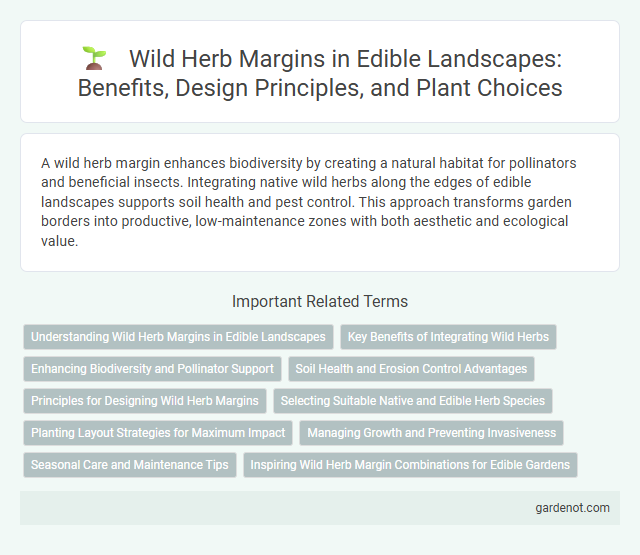A wild herb margin enhances biodiversity by creating a natural habitat for pollinators and beneficial insects. Integrating native wild herbs along the edges of edible landscapes supports soil health and pest control. This approach transforms garden borders into productive, low-maintenance zones with both aesthetic and ecological value.
Understanding Wild Herb Margins in Edible Landscapes
Wild herb margins in edible landscapes serve as biodiverse buffer zones that promote ecosystem health while providing foraging opportunities. These margins support beneficial insects, improve soil fertility, and act as natural pest control agents through diverse herbaceous species such as yarrow, nettle, and dandelion. Incorporating wild herb margins enhances sustainability by fostering plant resilience and boosting crop yields in permaculture and agroecological designs.
Key Benefits of Integrating Wild Herbs
Integrating a wild herb margin into an edible landscape enhances biodiversity by attracting pollinators and beneficial insects essential for ecosystem health. These herbs improve soil quality through natural nutrient cycling, reducing the need for synthetic fertilizers while providing a sustainable source of fresh, flavorful ingredients. The margin also serves as a natural pest deterrent, promoting a balanced, chemical-free garden environment.
Enhancing Biodiversity and Pollinator Support
Wild herb margins play a crucial role in enhancing biodiversity by providing diverse habitats that support various insect species and soil microorganisms. These margins attract pollinators such as bees, butterflies, and hoverflies, which improve pollination rates for surrounding edible plants. Incorporating wild herb margins into edible landscapes fosters ecological balance and promotes sustainable food production through natural pest control and increased plant resilience.
Soil Health and Erosion Control Advantages
Wild herb margins enhance soil health by increasing organic matter and promoting beneficial microbial activity, which improves nutrient cycling and soil structure. The deep root systems of wild herbs stabilize the soil, significantly reducing erosion caused by water runoff and wind. These margins also act as natural barriers that protect adjacent crops from nutrient loss and soil degradation, fostering sustainable agricultural practices.
Principles for Designing Wild Herb Margins
Designing wild herb margins requires selecting native, drought-tolerant herbs that support local biodiversity and soil health while providing edible and medicinal benefits. Incorporating varied plant heights and flowering periods ensures continuous habitat for pollinators and soil stabilization. Maintaining natural growth cycles and minimizing chemical inputs encourages a resilient, self-sustaining edible landscape.
Selecting Suitable Native and Edible Herb Species
Selecting suitable native and edible herb species for a wild herb margin involves prioritizing local flora that thrive in the existing soil and climate conditions. Species such as wild garlic (Allium ursinum), chickweed (Stellaria media), and dandelion (Taraxacum officinale) provide both ecological benefits and culinary value. Incorporating diverse native herbs enhances biodiversity while ensuring a sustainable and productive edible landscape.
Planting Layout Strategies for Maximum Impact
Planting wild herb margins enhances biodiversity by creating layered vegetation structures that support pollinators and beneficial insects. Strategic placement involves alternating clusters of native wild herbs such as wild garlic, yarrow, and chives to maximize space, improve soil health, and ensure staggered bloom periods for continuous forage. Incorporating companion planting principles boosts overall resilience and productivity of the edible landscape.
Managing Growth and Preventing Invasiveness
Maintaining a wild herb margin requires strategic pruning and selective harvesting to control plant density and prevent aggressive species from dominating. Using mulch and targeted weeding helps suppress invasive growth while promoting biodiversity within the edible landscape. Regular monitoring and timely intervention ensure a balanced ecosystem that supports native herbs without compromising surrounding vegetation.
Seasonal Care and Maintenance Tips
Wild herb margins thrive with seasonal care that includes regular pruning to encourage fresh growth and prevent overcrowding. Mulching in early spring conserves moisture and suppresses weeds, supporting healthy root development. Monitoring soil moisture and removing invasive species during the growing season ensures optimal growth and biodiversity.
Inspiring Wild Herb Margin Combinations for Edible Gardens
Wild herb margins enrich edible gardens by creating diverse, flavorful, and visually appealing edges that support pollinators and improve soil health. Combining herbs like rosemary, thyme, chives, and nasturtium fosters a dynamic ecosystem that deters pests naturally while offering fresh, aromatic ingredients for cooking. Strategic layering of wild herbs enhances biodiversity and maximizes space in sustainable garden designs.
Wild herb margin Infographic

 gardenot.com
gardenot.com